|
|
File
Museum of the Roman Centuriation – Borgoricco
|
Viale Europa 12 – 35010 Borgoricco (PD)
– Fax 049 933 5726 |
  |
|
Summary
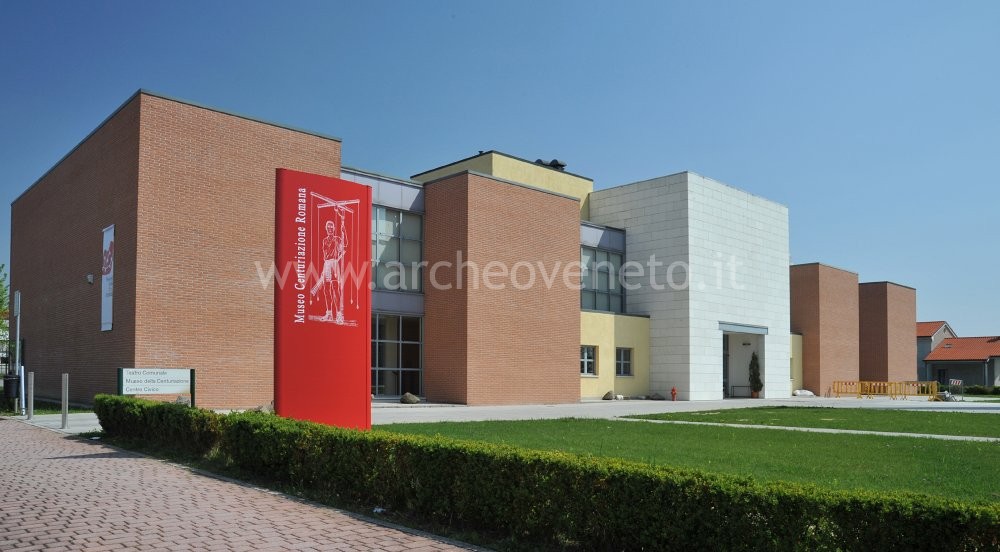
The museum was established with the purpose of presenting the history of the area located in the north-eastern part of the province of Padua, which during the Roman age was characterized by an important process of division and distribution of the land, known as centuriation. This phenomenon, which still today is visible in this area, is clearly described and explained in the museum thanks to the exhibition of a remarkable amount of archaeological finds discovered in the involved area. The exhibition path approaches the topic starting from the relation to the land, which is the core part as it mirrors the relation between human beings and nature.
|

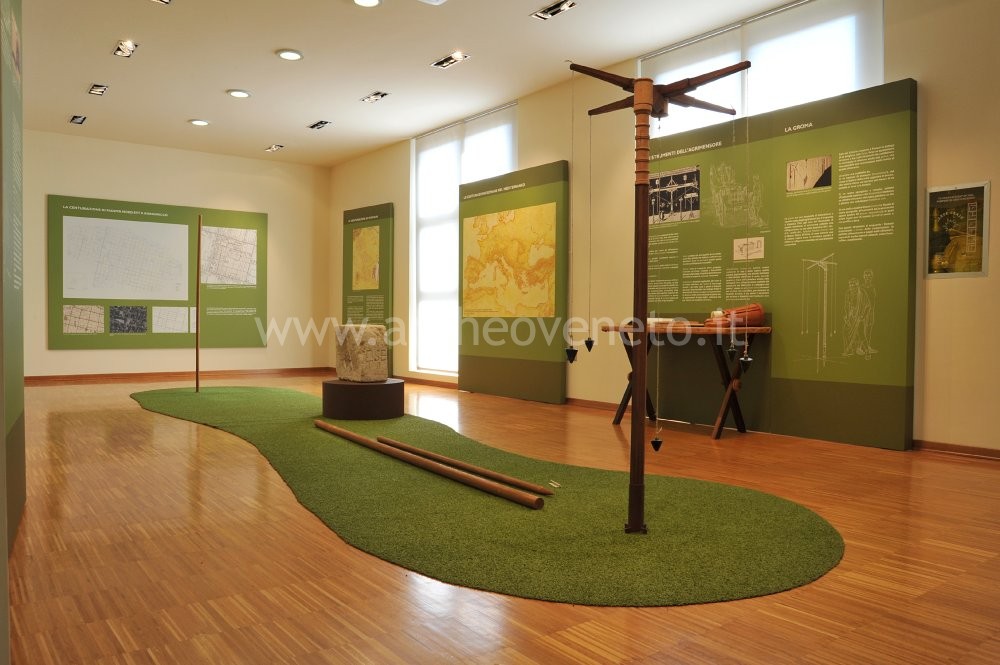 The first room on the left contains a set of panels providing basic information to understand the Roman field system (centuriation), which was used to exploit, reclaim and defend the land. The first context analysed is Borgoricco, then the scope of the analysis gradually enlarges to finally embrace the whole Mediterranean area with the identification of the places in which the Roman field system was adopted. The first room on the left contains a set of panels providing basic information to understand the Roman field system (centuriation), which was used to exploit, reclaim and defend the land. The first context analysed is Borgoricco, then the scope of the analysis gradually enlarges to finally embrace the whole Mediterranean area with the identification of the places in which the Roman field system was adopted.
The following panel describes the tools used by the land surveyor (T-square, ruler, compass, plumb-bob, parchment, wax tablets), the reproductions of which can be seen on the table placed below the panel. In the middle of the room there is the reproduction of a groma, one of the most important surveying instruments. Next to it, it is possible to see a boundary stone found in the countryside surrounding Borgoricco.
The other topic addressed in this room regards the ancient Roman units of measurements, which are explained thanks to modern reproductions of the digitus (digit), palmus (palm), pes (foot), cubitus (cubit) and gradus (step) to help visitors to understand the real size. Another topic, closely related to measurements, is the road construction technique, which is described thanks to the pictures of roads paved with blocks of stone or of lava that were found in various Mediterranean sites (Aquileia, Pompei, Italica) and to the modern reconstruction of the section of a Roman road.
The last part of the room is devoted to the funerary practices. After a general introduction to the topic, which can be found on the panel, more detailed information is provided by the display case that contains the grave goods of a cremation burial (nails, iron bill hook, bone objects, glass beads, bronze fibulae, ring, copper coin, Augustus quadrans, earthen lamp, glass unguentarium and gravestone) found in Borgoricco in the property previously belonging to the Mometto family, which can be traced back to the first half of the 1st century A.D.
|

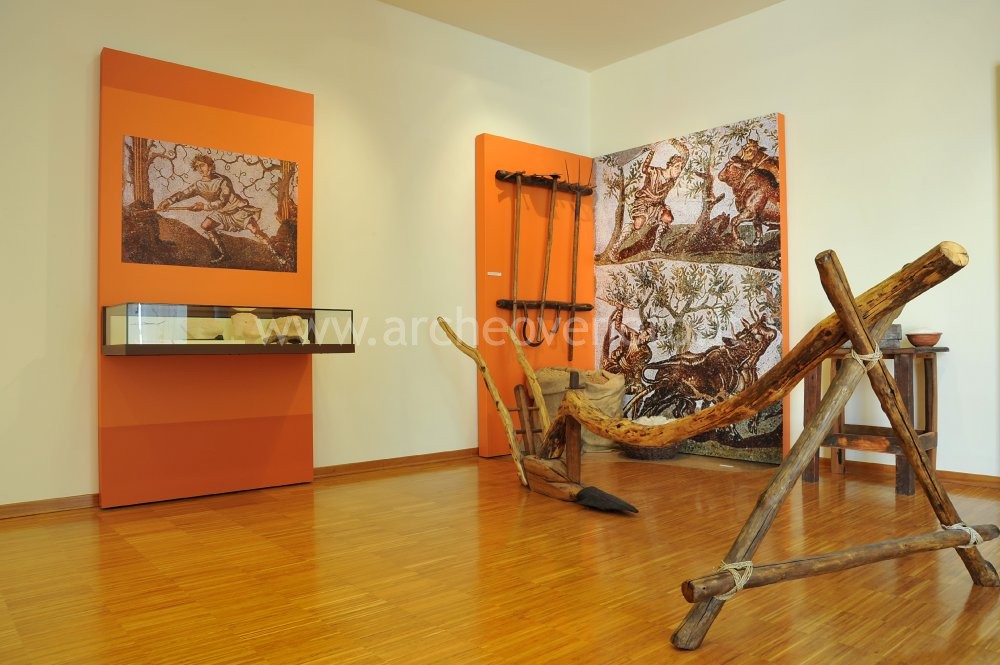 The second room addresses the activities linked to the centuriation (field system). The path goes on from the left side of the room, where it is possible to see some panels providing information on: division and distribution of the land (explaining how the land was divided within each centuria), the boundary worship (showing that the protection of the land and its boundaries relied not only on human laws but also on the divine intervention), farming and stock breeding. The last two panels are supported by the reproduction of a wooden plough, some tools linked to the farming world (hoe, pitchfork, sickle and bill hook) and some products used by the rural communities (sacks with spelt and baskets with wool), which can be seen in the centre of the room. The only two original finds displayed in this room are some fragments of dolia and numerous iron blades of farming tools. The second room addresses the activities linked to the centuriation (field system). The path goes on from the left side of the room, where it is possible to see some panels providing information on: division and distribution of the land (explaining how the land was divided within each centuria), the boundary worship (showing that the protection of the land and its boundaries relied not only on human laws but also on the divine intervention), farming and stock breeding. The last two panels are supported by the reproduction of a wooden plough, some tools linked to the farming world (hoe, pitchfork, sickle and bill hook) and some products used by the rural communities (sacks with spelt and baskets with wool), which can be seen in the centre of the room. The only two original finds displayed in this room are some fragments of dolia and numerous iron blades of farming tools.
|

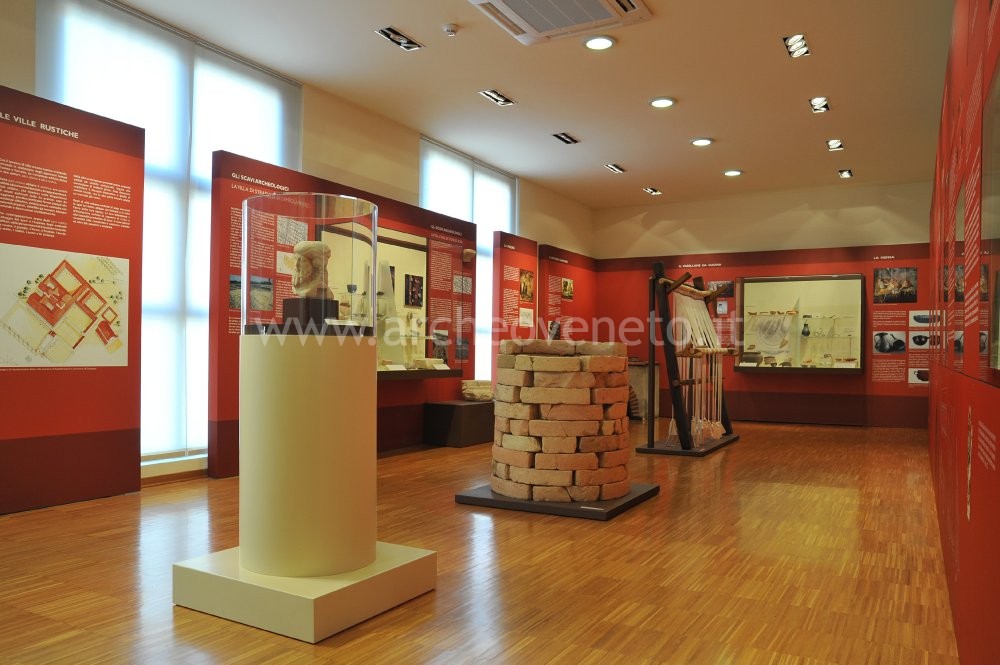 The third room is the largest one and it is also the one provided with the largest collection of finds. The first panels on the left side of the entrance door address the topic of residential buildings in their different aspects: floors and walls, building materials, structures and finally roofs. Beside the panels, it is possible to see some finds, such as mosaic tiles, fragments of floor tiles and column bricks, which can be traced back to a time span from 1st cent. B.C. to the 2nd cent. A.D. Next to the display case, there is the reconstruction showing the composition of a roof with tiles, curved tiles and antefixes. The third room is the largest one and it is also the one provided with the largest collection of finds. The first panels on the left side of the entrance door address the topic of residential buildings in their different aspects: floors and walls, building materials, structures and finally roofs. Beside the panels, it is possible to see some finds, such as mosaic tiles, fragments of floor tiles and column bricks, which can be traced back to a time span from 1st cent. B.C. to the 2nd cent. A.D. Next to the display case, there is the reconstruction showing the composition of a roof with tiles, curved tiles and antefixes.
The second section of the room is devoted to the archaeological excavation carried out in the area near Borgoricco. Two panels and a large display case describe the archaeological finds discovered in the villa of Straelle in Camposampiero and in the villa of the former Fondo Rossi. The items found during the excavation in both archaeological sites consist of some fragments of stamped tiles, loom weights, a bronze coin (1st cent. A.D.), fragments of grey pottery of local production, numerous floor tiles and mosaic tiles, as well as a few fragments of painted wall plaster (1st cent. B.C. – 2nd cent. A.D.).
The third part of the room focuses on the domestic activities that characterized everyday life in the Roman world. First of all there are the eating habits, which are explained thanks to the reconstruction of a fireplace of a Roman kitchen and to the display case containing cooking pottery (fragments of ollas, lids, pans and mortars of the 1st cent. A.D. – 2nd cent. A.D.) as well as table pottery (fragments of bowls, jugs, small plates, sigillata, thin walled and bronze pots).
Another important activity was weaving, as proven by the reproduction of a large wooden vertical loom at the centre of the room and a display case containing loom weights, reels and spindle whorls of the 1st cent. B.C. The issue of weaving is closely linked to the topics of clothing (described though graphic reconstructions and the display cases containing bronze fibulae and glass buttons that can be traced back to a time span between the 1st cent. B.C. and the 3rd cent. A.D.) and of cosmetics (explained through the exhibition of glass unguentaria, a bronze strigil, glass beads, a ring and a pair of tweezers, all dating back to the early Imperial Age).
The following display cases contain objects referring to home furnishing (bronze furniture applications, lamps, bronze and iron keys), play activities (glass and terracotta pawns) and domestic cults (fragment of a bronze votive hand with a snake, fragment of a small stone column belonging to a lararium), which date back to a time span between the 1st and the 3rd cent. A.D.
At the centre of the room particularly noteworthy are the herma of Dionysus and Silenus of the 1st cent. A.D. and a well of the Roman Age found in the Fondo Bressanin in Borgoricco.
|

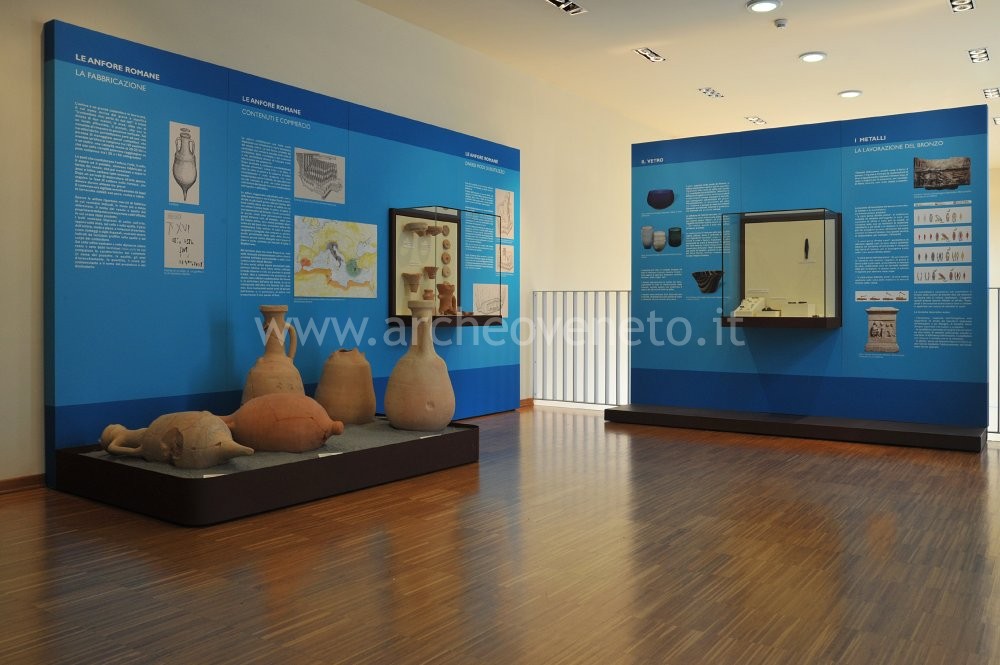 The last room focuses on the commercial activities carried out in the area conquered by Rome. The first activity presented is the brick production, which is well explained thanks to the reproduction of a rectangular brick kiln used in the firing of bricks. Next to the kiln it is possible to see a large panel explaining the way the marks stamped on the bricks should be read, which can be traced back to a time span between the 1st cent. B.C. and the 1st cent. A.D. The last room focuses on the commercial activities carried out in the area conquered by Rome. The first activity presented is the brick production, which is well explained thanks to the reproduction of a rectangular brick kiln used in the firing of bricks. Next to the kiln it is possible to see a large panel explaining the way the marks stamped on the bricks should be read, which can be traced back to a time span between the 1st cent. B.C. and the 1st cent. A.D.
The central part of the room displays the archaeological finds discovered during the excavation of the handicraft workshop in the former Fondo Mometto (1st cent. A.D.), which consist of fragments of earthen architectural elements (engraved terracotta plaques and antefixes), fragments of stamped tiles, a large ceramic mortar with a hole and a terracotta bowl.
The following panel addresses the topic of amphoras, from their manufacturing to the explanation of their commercial function and the different ways in which they were used. Below and next to the panel, it is possible to see some whole wine and oil amphoras (mid 1st cent. B.C. – mid 1st cent. A.D.) as well as rim fragments, tips, handles and tops of amphoras coming from the Alta Padovana (northern area of the province of Padua).
The last panels focus on the working of glass and metals, presenting a set of finds discovered thanks to the field walking technique in the centuriae of the countryside of Borgoricco, such as fragments of pots in glass (1st cent. A.D. – 2nd cent. A.D.), bronze and iron. This issue is closely linked to the study of the units of measurement and of coins. Both topics are addressed through the presentation of the finds discovered in the local excavation, which include lead steelyard counterweights and scale weights, as well as a rich numismatic collection.
|
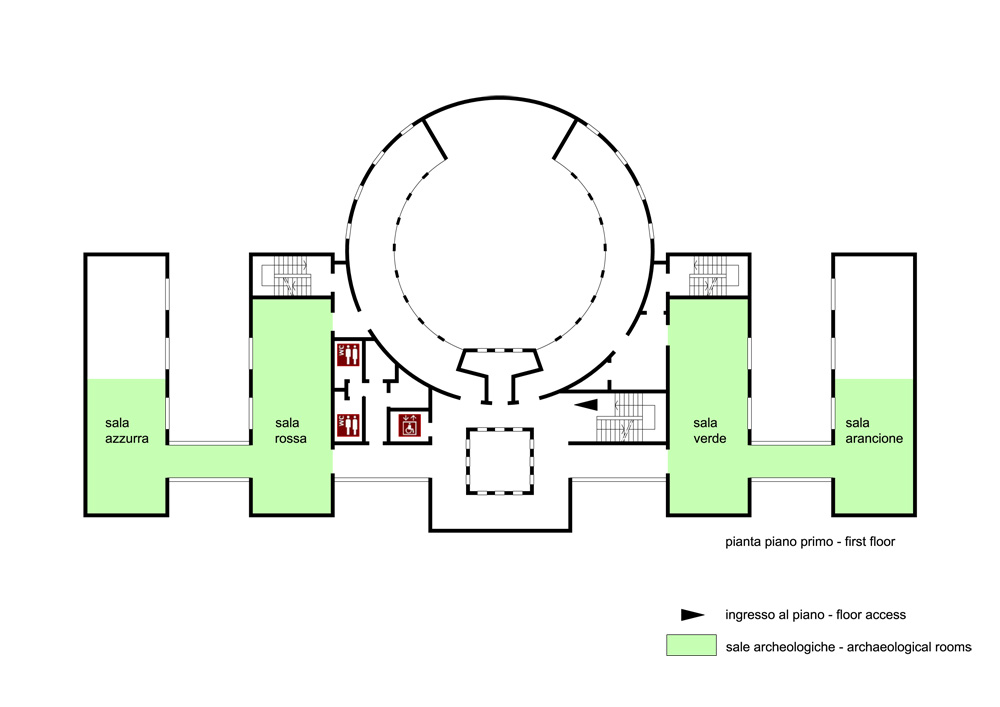
Admission: Negli orari di apertura
Ticket: Si
Price: Full fare: 2€; reduced fare (children aged between 7 and 14; seniors 65+ and school classes): 1€; free admission (children below 7 years of age, teachers, people with disabilities and their helpers).
 School access School access
 Disabled access Disabled access
The museum is provided with a lift.
Opening Days
| Tipology |
When |
Specs |
| Summer/Winter |
Tuesday |
9.00 – 12-30 |
| Summer/Winter |
Wednesday |
9.00 – 12.30 / 15.00 – 18.00 |
| Summer/Winter |
Thursday |
9.00 – 12.30 |
| Summer/Winter |
Friday |
9.00 – 12.30 / 15.00 – 18.00 |
| Summer/Winter |
Saturday |
9.00 – 12.30 / 15.00 – 18.00 |
Domenica e lunedì aperto su prenotazione. Luglio-Agosto: l’orario pomeridiano viene posticipato dalle ore 17.00 alle 20.00. Il Museo è chiuso nei giorni: 1 gennaio, 6 gennaio, lunedì di Pasqua, 25 aprile, 1 maggio, 2 giugno, 15 agosto, 1 novembre, 8 dicembre, 25-26 dicembre.
Recommended tour time (minutes): 60
 Toilet Toilet
 Parking Parking
 Bookshop Bookshop
At the ticket office
 Rest points Rest points
A bench can be found in the middle of the path.
 Brochure Brochure
 Information boards Information boards
 Mobile cards Mobile cards
 Multilingual ads: Italiano Multilingual ads: Italiano
Inglese
 Guided Tours Guided Tours
Booking compulsory
 Educational activities Educational activities
Booking compulsory. They are mainly carried out by two associations: Arc.a.dia and Heredia, both of which organize workshop activities and excursions.
 Educational workshops Educational workshops
A room is devoted to the workshop activities for children and to the projection of videos providing introductory and preparatory information on the museum.
 Library and documentation centre Library and documentation centre
| Musei d’Italia, Guida Touring Club Italiano 2003, Milano, pp. 207. |
| Bonetto J. 2009, Veneto (Archeologia delle Regioni d’Italia), Roma, pp. 399. |
|

